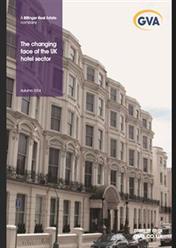GVA – The changing face of the hotel sector
A report by leading commercial property consultants, GVA, reveals that the hotel industry as a whole is experiencing a period of considerable change.
The overall outlook for the sector is positive, but it seems that as the economy picks up, the most profitable hotel stock will be that which appeals to large corporate occupiers (i.e. less risk to those looking to invest in the sector) and the smaller, independent operators will continue to face challenges on several fronts.
The report reveals that although the sector is growing as a property asset type, it is restructuring in relation to changing customer and investor expectations.
Investors tend to prefer hotels with high operational efficiency with over 100 bedrooms. ‘Covenant strength of the operator and/or trading performance’ as well as branding potential and the ‘longevity of the property to meet guests evolving requirements’ are key focus points.
The report states that during 2013, there were 70 hotel closures in the UK (making a loss of 2000 beds). Only 18% of these were part of a chain and 78% were 3 star and below, reiterating GVA’s claim that ‘Non-prime assets in tertiary locations’ were suffering the most.
Furthermore, it is revealed that this downward trend for independents is the tip of an ice-berg that has already sunk: it has been reported that between 2003 and 2013 nearly 40,000 hotel beds were lost and that most of these were in coastal spots where supply is high and facilities outdated and plummeting occupancy levels were compounded by the impact of the recession.
However, the hotel sector is in good enough condition to warrant the 27,000 new hotel beds scheduled to open by the end of 2015.
The revealing factor here is that 56% of these imminent beds are in the ‘budget sector’ (i.e. Premier Inn, Ibis, Holiday Inn) and only 2% in the independent sector (and almost all of these are in the ‘boutique’ category).
The report cites macro and micro-economic factors such as room rates, incremental spend, occupancy levels, location and condition of the building are vital factors in a hotel’s viability and, critically, how the financial crisis has created little leeway in any weak areas.
Rising food and energy costs, decreasing property values (leading to negative loan to value situations in some instances) and an inability to secure finance have added to the pressure and it seems that, even if one key factor is in place (e.g. a prime location), a lack of available funds to make improvements can mean a hotel is no longer a viable concern.
All these issues have led to many hotel owners and investors seeking to maximize the value of a site by changing its use. The report says 380 hotels submitted planning applications for such transformations between 2011 and 2012 and the most popular alternative use is private residential (52%), closely followed by nursing and care homes (20%).
As the larger, ‘high density’ national and international occupiers continue to flood into the market, this trend for smaller operations looking to maximize their value through alternate use looks set to continue.
Return to top ↑

